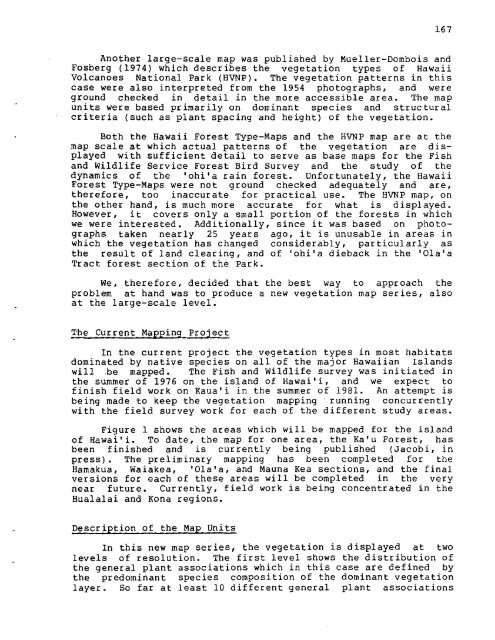June 1 - 3 , 1978 - University of Hawaii at Manoa
June 1 - 3 , 1978 - University of Hawaii at Manoa
June 1 - 3 , 1978 - University of Hawaii at Manoa
You also want an ePaper? Increase the reach of your titles
YUMPU automatically turns print PDFs into web optimized ePapers that Google loves.
Another large-scale map was published by Mueller-Dombois and<br />
Fosberg (1974) which describes the veget<strong>at</strong>ion types <strong>of</strong> <strong>Hawaii</strong><br />
Volcanoes N<strong>at</strong>ional Park (HVNP). The veget<strong>at</strong>ion p<strong>at</strong>terns in this<br />
case were also interpreted from the 1954 photographs, and were<br />
ground checked in detail in the more accessible area. The map<br />
units were based primarily on dominant species and structural<br />
criteria (such as plant spacing and height) <strong>of</strong> the veget<strong>at</strong>ion.<br />
Both the <strong>Hawaii</strong> Forest Type-Maps and the HVNP map are <strong>at</strong> the<br />
map scale <strong>at</strong> which actual p<strong>at</strong>terns <strong>of</strong> the veget<strong>at</strong>ion are dis-<br />
played with sufficient detail to serve as base maps for the Fish<br />
and Wildlife Service Forest Bird Survey and the study <strong>of</strong> the<br />
dynamics <strong>of</strong> the 'ohi'a rain forest. Unfortun<strong>at</strong>ely, the <strong>Hawaii</strong><br />
Forest Type-Maps were not ground checked adequ<strong>at</strong>ely and are,<br />
therefore, too inaccur<strong>at</strong>e for practical use. The HVNP map, on<br />
the other hand, is much more accur<strong>at</strong>e for wh<strong>at</strong> is displayed.<br />
However, it covers only a small portion <strong>of</strong> the forests in which<br />
we were interested. Additionally, since it was based on photo-<br />
graphs taken nearly 25 years ago, it is unusable in areas in<br />
which the veget<strong>at</strong>ion has changed considerably, particularly as<br />
the result <strong>of</strong> land clearing, and <strong>of</strong> 'ohi'a dieback in the 'Ola'a<br />
Tract forest section <strong>of</strong> the Park.<br />
We, therefore, decided th<strong>at</strong> the best way to approach the<br />
problem <strong>at</strong> hand was to produce a new veget<strong>at</strong>ion map series, also<br />
<strong>at</strong> the large-scale level.<br />
The Current Mapping Project<br />
In the current project the veget<strong>at</strong>ion types in most habit<strong>at</strong>s<br />
domin<strong>at</strong>ed by n<strong>at</strong>ive species on all <strong>of</strong> the major <strong>Hawaii</strong>an Islands<br />
will be mapped. The Fish and Wildlife survey was initi<strong>at</strong>ed in<br />
the summer <strong>of</strong> 1976 on the island <strong>of</strong> Hawai'i, and we expect to<br />
finish field work on Kaua'i in the summer <strong>of</strong> 1981. An <strong>at</strong>tempt is<br />
being made to keep the veget<strong>at</strong>ion mapping running concurrently<br />
with the field survey work for each <strong>of</strong> the different study areas.<br />
Figure 1 shows the areas which w i l l be mapped for the island<br />
<strong>of</strong> Hawai'i. To d<strong>at</strong>e, the map for one area, the Ka'u Forest, has<br />
been finished and is currently being published (Jacobi, in<br />
press). The preliminary mapping has been completed for the<br />
Hamakua, Waiakea, 'Ola'a, and Mauna Kea sections, and the final<br />
versions for each <strong>of</strong> these areas will be completed in the very<br />
near future. Currently, field work is being concentr<strong>at</strong>ed in the<br />
Hualalai and Kona regions.<br />
Description <strong>of</strong> the Map Units<br />
In this new map series, the veget<strong>at</strong>ion is displayed <strong>at</strong> two<br />
levels <strong>of</strong> resolution. The first level shows the distribution <strong>of</strong><br />
the general plant associ<strong>at</strong>ions which in this case are defined by<br />
the predominant species composition <strong>of</strong> the dominant veget<strong>at</strong>ion<br />
layer. So far <strong>at</strong> least 10 different general plant associ<strong>at</strong>ions
















